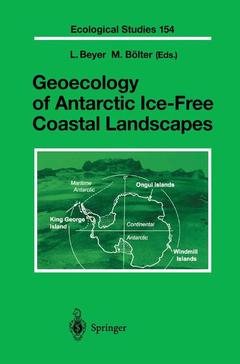I The Environment.- Preface.- Antarctic Coastal Landscapes: Characteristics, Ecology and Research.- The Antarctic Environments and Ecosystems.- Characteristics of Antarctic Coastal regions.- The Former Use of ‘Oasis’ as a Synonym for Ice-Free Landscapes.- Characteristics of Antarctic Coastal Landscapes.- Localities and Topography.- Soils of Antarctic Coasts.- Conditions for Colonisation of Soils.- Development and Maturation.- Research Programmes and Objectives.- References.- Maritime and Continental Antarctic: The Sites of Investigation in Context 17.- Geography and Geology.- Climate.- The Effects on Soil Ecosystems.- References.- King George Island — South Shetland Islands, Maritime Antarctic.- Geographical Features.- Cartographic and Topographic Features.- Surroundings.- Shores.- The Sea Basin.- Changes of Climate.- Temperature.- Radiation.- Climatic Differentiations.- Climatological Effects.- Periglacial Features and Processes.- Variability in the Terrestrial Ecosystem.- References.- Wilkes Land (Casey Station).- The Windmill Islands — Physical.- Geology and Geomorphology.- Holocene Emergence.- Climate.- References 46.- Dronning Maud Land and Its Environments.- Geographical Zone of Dronning Maud Land.- Climatic Zonations.- Distribution of Mosses, Lichens and Soil Algae.- Soil Properties.- Particle Size Distributions.- Electrical Conductivity and pH(H20).- Water Availability.- Nutrients.- Environmental Monitoring.- Human Activity and Long-Range Dispersal.- References.- II Soils, Soil Development and Soil Properties.- Preface.- Glacial Changes in the Areas of Admiralty Bay, Potter Cove, King George Island, Maritime Antarctica.- Climate Change Indications in the of the Antarctic Peninsula.- Satellite Images and Historical Maps.- Glacier Retreat in Admiralty Bay and Potter Cove.- Tidewater Glaciers.- Glaciers Terminating on Land.- Possible Reasons for the Differences in Glacier Retreat of the Tidewater Glaciers in Admiralty Bay.- Conclusion.- References.- Soils and Soilscapes.- Sites and Analyses.- Soil Conditions.- Windmill Islands (Casey Area).- King George Island (Arctowski Area).- Soil Classifications.- Soilscapes.- Windmill Islands.- King George Island.- Conclusions.- References.- Weathering and Soil Formation.- Sites and Methodology.- Soil Analyses.- Lithology of the Sites and Mineralogy of Soils.- Soil Forming Processes and Their Products.- Weathering, Acidification and Mineral Formation.- Humus Accumulation and Biotic Aggregation.- Podzolisation.- Carbonisation, Salinisation and Alkalisation.- Redoximorphism.- Conclusions.- References.- Refractory Soil Organic Matter — Formation, Accumulation, Translocation and Transformation.- Sites and Analyses.- Soil Organic Matter — Distribution and Accumulation.- Soil Formation and SOM Translocation.- 13C-NMR Spectroscopy.- PyGC/MS Analysis.- Soil Formation and SOM Transformation.- Conclusions.- References 156.- Ornithogenic Ecosystems in the Maritime Antarctic Formation, Development and Disintegration.- Colonisation of Antarctic Coast by Sea Vertebrates.- Marine Vertebrates in the Maritime Antarctic Paleoecosystem.- Colonisation of Land by Sea Vertebrates During Glacial/ Interglacial Cycles.- Impact of Sea Animals on Terrestrial Ecosystem Formation.- Ornithogenic (Penguin) Soils in the Maritime Antarctic.- Mineralisation of Guano.- Ornithogenic Waters.- Phosphatisation — the Main Ornithogenic Soil Forming Process in the Maritime Antarctic.- Ornithogenic Soils of Active Rookeries.- Ornithogenic Soils of Abandoned Rookeries.- Development of Terrestrial Ornithogenic Ecosystems.- Biogeochemical Cycle of Ornithogenic Matter on the Land/Sea Boundary.- References.- III Soil Microbes, Plants and Soil Fauna.- Preface.- Heterotrophic Soil Microbes, Microbial and Enzymatic Activity in Antarctic Soils.- The Microbial Community.- Bacterial Counts.- Bacterial Biomass.- Fungi and Yeasts.- Microbial Activity.- Bacterial Activity.- Turnover Times of Glucose.- Respiration of Glucose.- Biomass Production Based on Glucose Metabolism.- Enzymatic Activity.- CO2 Evolution and O2-Consumption.- Driving Factors of Microbial Activity.- Environmental Conditions.- Dissolved Organic Matter.- Mineralisation of Guano.- References.- Plant Communities on King George Island.- Comments on the Flora.- A Review of Important Plant Communities on King George Island.- Communities of Rock Substrates.- Nitrophobic Communities.- Halophilous and Nitrophilous Communities.- Terricolous Communities.- Communities with Vascular Plants.- Communities with a Predominance of Bryophytes.- Communities with a Predominance of Lichens.- The role of Animals in Antarctic Terrestrial Ecosystems.- Distribution of the Principal Terrestrial Ecosystems.- References.- Plant Communities at Wilkes Land.- Flora and Vegetation of the Windmill Islands.- Geology, Geomorphology and Vegetation Patterns.- Plants in the Terrestrial Ecosystem.- Ecophysiological Adaptations of the Flora.- Environmental Impacts and Conservation Issues.- References.- Plant Communities at Dronning Maud Land.- Vegetation in Dronning Maud Land.- Vascular Plants.- Cryptogamic Organisms.- Moss Habitats and Communities.- Soil Algal Communities in the Vicinities of Syowa Station, East Dronning Maud Land.- References.- Soil Fauna of Antarctic Coastal Landscapes.- Faunal Composition.- Ecology and Physiology.- Interhabitat Dispersal and Population Genetic Structure.- Potential Responses to Environmental Change.- Further Research.- References.- IV Integrating Aspects for Soil Ecology in Antarctic Coastal Landscapes.- Preface.- Soils as Habitats for microorganisms.- The Microbial Environment.- The Stone Sphere.- The Aggregate Sphere.- Resource Competition.- Water as a Controlling Factor.- Consequences of Changing Water Availability.- Osmotic Stress.- Physical Effects on the Habitat While Freezing and Thawing.- Ecological Rating of Habitats — An Example from Antarctic Sites.- Adaptation — A Clue to Survival in Harsh Environments?.- References.- Ecological Classification of Terrestrial Algal Communities in Polar Environments.- Environmental Constraints.- Climate.- Hydrology and Permafrost.- Habitat Classification.- Hydro-Terrestrial Environments.- Terrestrial Environments.- Conclusion.- References.- Plants and Lichens in the Antarctic, Their Way of Life and Their Relevance to Soil Formation.- Vascular Plants.- Immigration and Distribution in Antarctica.- Physiological Properties Allow Existence in Antarctica.- Relevance of Vascular Plants for Soil Formation.- Bryophytes.- Bryophytes, as a Component of Antarctic Vegetation.- Physiological Properties That Enable Bryophytes to Live in Antarctica.- Productivity and Growth.- Growth Forms and Strategies.- Phytomass.- Other Organisms Attached to Bryophytes.- Decomposition and Mineralisation.- Catchment of Debris, Detritus, Airborne Particles, Air Spora and Trace Substances.- Nutrient Cycling.- Lichens.- Floristic Remarks.- Physiological Properties That Enable Lichens to Exist in Antarctica.- Growth and Growth Forms.- Colonisation and Succession.- Relations to the Substratum.- Ion Uptake.- Contribution to Pedogenetic Processes.- Conclusions.- References.- Soil Ecology in Relation to Plant Patterns.- Sites and Environmental Constraints.- Soils — Texture and Nutrients.- Vegetation Patterns.- Relationships Between Soils and Vegetation.- Snow and Water as Structural Components.- Conclusion and Needs for Future Research.- References.- Uses, Preservation and Protection of Antarctic Coastal Regions.- Ecological Background.- Ecosystem Development.- Colonisation by Seabirds and Seals.- Occupation, Uses and Impacts by Man.- Research Installations.- Tourism.- Disturbance and Remediation.- A Terminology for Disturbance and Damage.- Remediation.- Coastal Landscapes and Global Change.- Conservation of Coastal Landscapes.- References.- Concluding Remarks.- Taxonomic Index.- Geographical Index.




